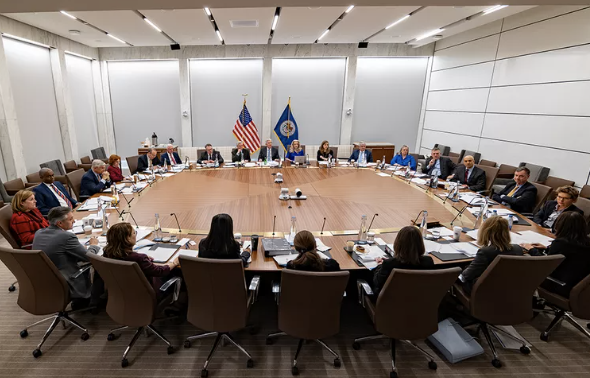The Federal Open Market Committee (FOMC) has decided to keep its benchmark interest rate steady at 5.25% to 5.5%, maintaining the highest level seen over two decades for the seventh consecutive meeting. Projections now indicate that the Federal Reserve anticipates only one rate cut in 2024, a reduction from the previously forecasted three cuts. Despite better-than-expected consumer price data in May, the Fed has also raised its inflation forecasts.
Investors remain more optimistic than the Fed, predicting two rate cuts in 2024, with a higher likelihood of the first reduction occurring in September. During the press conference, Fed Chair Jerome Powell downplayed the significance of these projections, noting that “most” officials likely did not incorporate the latest lower-than-expected inflation figures from May. Employment growth and consumer spending have shown surprising resilience despite high borrowing costs. While inflation has significantly slowed after a sharp rise during the pandemic, it still exceeds the 2% target.
The latest projections from the Federal Open Market Committee (FOMC) show a significant difference of opinion within the committee, which adds complexity to the current economic situation. The “dot plot” indicates that seven officials expect a reduction in interest rates this year, eight anticipate two rate cuts, and four do not expect any. This divergence suggests that some officials believe that increasing borrowing costs may not have as large of an impact on slowing the economy as previously expected. In contrast, others believe the current policy is well-positioned to bring inflation back to the Federal Reserve’s target. This highlights the ongoing debate within the committee.
The debate over interest rates is far from over, and its outcome could have significant implications for the future trajectory of the U.S. economy. The challenge of explaining the resilience of the U.S. economy will continue to perplex and likely divide the FOMC. The explanation that inflation is transitory and caused by supply chain issues due to COVID-19 is no longer sufficient. Increasingly, economists are rallying around a different explanation: monetary policy may not be as tight as believed. In other words, the neutral interest rate adjusted for inflation—the level that neither stimulates nor restrains growth—is higher than Fed officials estimate. This would mean that the current federal funds rate is less restrictive for growth.
Significant budget deficits and public investments in a decarbonized economy support this argument. Additionally, the end of globalization, a deflationary phenomenon, the rise of protectionism, and the emergence of regionalization in the global economy add further weight to this explanation. These factors, some of which are structural, have pushed up the neutral interest rate.
If this hypothesis proves correct in the coming months, a rate reduction is far from certain. In the event of external shocks in commodities or the extension of ongoing conflicts, the Fed’s next move might not be a rate cut.
